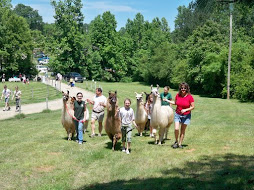History
Llamas are members of the camel (camelid) family. Originating in the Central Plains of North America about 10 million years ago, the llama predecessors migrated to South America around 2.5 million years ago. Its cousin, the camel , relocated to the Middle East and other regions of the world. The end of the Ice Age 10,000 to 12,000 years ago marked the extinction of the camelid in North America. Llamas were domesticated from the guanacos of the Andean highlands of Peru 5,000 to 6,000 years ago and are among the world's oldest domestic animals. While primarily a beast of burden for the native herdsmen, llamas also provided them with meat, wool, hides for shelter, manure pellets for fuel, and became sacrificial offerings to their gods. Today there are an estimated 7 million llamas and alpacas in South America. In the United States and Canada there is an estimated 65,000 llamas , 7,000 alpacas and 200 guanacos. Llamas have international appeal, with countries such as New Zealand augmenting their fiber industry with llama and alpaca wool. As in ancient times, the llama today is important to the agricultural economy of the remote highlands of Argentina, Bolivia, Chili and Peru. In North America the llama and alpaca industry is recognized as a viable agriculture entity.
Physical factsLife span: about 15 to 29 years
Weight: 200 to 450 pounds
Height: 36" to 47" at the shoulder, 5' to 6'5" at the head
Average Gestation: 350 days (11.5 months)
Color: A llama may be solid, spotted, or marked in a wide variety of patterns, with wool colors ranging from white to black and many shades of gray, beige, brown, red and roan in between.
Reproduction, Birth and Babies: Females are first bred at 16 to 24 months of age. Llamas do not have a heat cycle; they are induced ovulators (ovulation occurring 24 to 36 hours after breeding). Llamas can be bred at any time of the year. A single baby ("cria") is usually delivered from a standing mother, normally without assistance. Most births occur during daylight hours, which is better for the cria and most certainly more convenient for the llama owners. Twinning is a rare occurrence. Normal birth weights are between 20 to 35 pounds, and the cria usually stands and nurses within 90 minutes. Depending upon the cria's size and the mother's condition, the baby is weaned at 4 to 6 months.
Health and Basic Medical Needs: Because their ancestors evolved in the harsh environment of the Andean highlands, North American llama owners have founds them to be generally easy to care for. The recommended primary care of yearly vaccinations, routine wormings, and regular toenail trimming help llamas remain hardy and healthy.Frequently asked QuestionsWhat are they used for? Contemporary North American llamas are primarily recreational animals. They are bred and raised for packing, wool production, cart pulling, animal facilitated therapy, companion animals, exhibition in shows, parades and fairs, and guardians of other livestock such as sheep. The llama is becoming increasingly popular as a project animal for 4-H, Scouts, FFA and other youth activities. For the outdoor enthusiast and athlete, there are numerous activities and competitive events that team up the llama and his owner. Llamas are great family fun!Can you use their wool? Grease-free and lightweight, llama wool is warm and luxurious. A valuable commodity sought after by fiber artists, such as weavers and spinners, the wool is a marketable product for llama owners.Are they intelligent? Yes, which is why llamas can quickly learn to accept a halter, follow on a lead, load in and out of a vehicle, or carry a pack. Are they good pack animals? Sure-footed and agile, most llamas are excellent packers and can carry an average of 80 lbs or 25% of their body weight. Their two-toed foot with its leathery pad gives the llama a low environmental impact equivalent to that of a considerate hiker's athletic shoe. Their ability to browse lessens their intrusion on the native vegetation, which is one of the reasons llamas are gaining in popularity with environmentally conscious users and managers of our public lands. Historically llamas have carried packs for man ; however some llamas have been trained to carry a small child.What do they eat? Llamas are modified ruminants with a three-compartment stomach. Like cattle and sheep, they chew their cud. Because of a relatively low protein requirement and an efficient digestive system, they can be kept on a variety of suitable pastures or hay, with the supplementation of recommended vitamins, minerals and salt. A llama costs significantly less to feed than other comparable-sized animals.What is their personality like? Because they are highly sociable herd animals, llamas need the companionship of other llamas. Independent yet shy, llamas are gentle and curious. Their generally calm nature and common sense make a trained llama easy for anyone to handle and an excellent choice for a child's pet and companion.What sounds do they make? Llamas communicate by humming. They also express themselves through a series of ear, body, and tail postures. On rare occasions they will alert their companions and human keepers with a distinctive alarm call to the presence of unfamiliar dogs or other creatures which they perceive as threats. During breeding males make a distinctive orgling sound.Do they spit? Llamas will spit at other llamas in order to establish the pecking order within the group, to ward off an unwanted suitor, or to say "Bug off!". A llama who has been mishandled, feels abused, or threatened may occasionally spit at humans.
Thursday, June 4, 2009
Subscribe to:
Post Comments (Atom)















































No comments:
Post a Comment